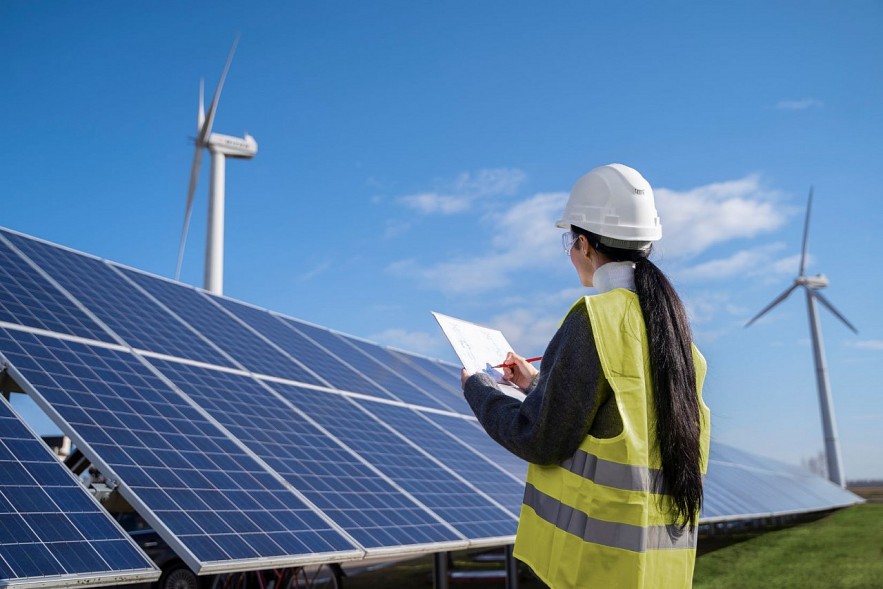
In November 2021, at the United Nations Climate Change Conference (COP26), Vietnam pledged to phase out unabated coal power by 2040 and achieve net zero emissions by 2050. At COP28 in December 2023, Vietnam extended its climate commitments by joining the Global Cooling Pledge, which aimed to reduce greenhouse emissions from the cooling industry by at least 68% by 2050.
Vietnam continues to bolster its efforts in addressing climate change, particularly by increasing the use of renewable energy technologies. Wind and solar consumption have quadrupled since 2019, making Vietnam the world’s tenth-biggest solar power producer, and plans are underway for more projects.
One of the most crucial policy documents to guide Vietnam’s transition to renewable and climate-friendly energy solutions is its Power Development Plan 8 (PDP8). Under PDP8, the government aims to have renewable energy comprise 50% of the energy mix by 2050 while phasing out all coal-fired plants.
What is driving this renewable energy push in Vietnam?
Vietnam faces significant physical risk from the negative impact of climate change, especially in the Mekong Delta. However, other drivers may be motivating this transition.
First, financing for traditional dirty “coal-driven” energy projects is drying up. Traditional energy funding sources, such as China, South Korea, and Japan, are shifting focus to funding renewable technologies.
Second, many of the world’s largest international manufacturers, including firms already operating in Vietnam, such as Apple, H&M, the LEGO Group, Nike, Nestle, PepsiCo, and Samsung, have committed to the global RE100 initiative. These companies aim to have 100% renewable energy by 2050. Hence, Vietnam risks losing their interest and new potential investors if it cannot meet its increased renewable-energy demands.
Finally, there is increasing competition in renewable energy power generation from Vietnam’s neighbours. Cambodia, Laos, Myanmar, and Indonesia invest significantly in renewable power generation. Malaysia has also set targets for 70% renewables by 2050.
Challenges ahead
To what extent can Vietnam achieve its ambitious renewable energy generation targets?
Coal remains a pivotal energy source in Vietnam, contributing approximately 45% toward energy demand in 2022, followed by hydropower at 30% and oil and gas at 11%. Shifting away from coal-fired plants presents challenges, particularly considering Vietnam’s booming energy demands, the intermittent supply of renewable energy, and the ready supply of cheap coal.

Renewable energy projects continue to face economic hurdles under the current tariffs regime in Vietnam, making them less attractive to developers. The absence of direct power purchase agreements and the lack of instituted financing mechanisms impede the progress of renewable energy initiatives. Additionally, increases in Vietnam’s energy prices to make renewable energy projects more viable could trigger objections from consumer groups and deter foreign investment.
There is also a need for better coordination among key government agencies. Interagency collaborations are important in the complex regulations on the financial disbursements for official development assistance projects, and this, in turn, can become an obstacle to gaining the involvement of the private sector in these projects.
Renewable technologies, such as solar and wind, are new and require new skill sets in installing and managing these facilities. Technical capabilities are also needed to support the transition of the electrical grid from carbon based to renewable technologies, in policy development, and in creating new innovative financial mechanisms that can fund new renewable energy projects.
Opportunities remain
Despite these challenges, opportunities remain. Last December, Vietnam signed a new Just Energy Transition Partnership (JETP). The agreement is holistic in its approach covering areas including policy enhancements, technology transfer, and financial support for a just energy transition. It is also geared to mobilise investments to drive renewable energy development, improve energy efficiency, and upgrade grid infrastructure. Partners have already committed to mobilising an initial US$15.5 billion over the next three to five years to help catalyse the just energy transition in Vietnam.
There also remain tremendous opportunities for the participation of the Vietnamese private sector. VinaCapital is among the local stakeholders of SkyX, a solar rooftop power developer headquartered in Ho Chi Minh City. Recently, SkyX achieved a valuation exceeding US$100 million.

What are the next steps?
To achieve the renewable energy target, a range of innovative actions are needed, including:
- Increasing the share of wind and solar in total electricity generation. While this is already ‘in hand’, more needs to be done to support greater private sector participation and to fast track existing projects. Fundamental to this is addressing the issue of renewable energy tariffs and direct selling power agreements, coupled with necessary institutional and regulatory strengthening to support the timely implementation of these projects.
- Improving the transmission grid and electricity storage capacity are essential to support the distribution of renewable energy, particularly to more rural locations. Indeed, many international donors are making big investments in grid upgrades globally.
- Exploring and implementing new forms of renewable technologies. Wave power remains an untapped renewable energy source for Vietnam, given its long coastline and the increasing availability of modular wave technologies. There are also opportunities to combine various types of renewable technologies, such as solar, wind, and hydroelectricity, based on the suitability of the locations, as is being done in the province of Ninh Thuan, to increase supply capacity and reliability.
- Given that coal generation will likely be in Vietnam’s power generation mix for some time, there is an opportunity to clean existing and planned thermal power plants.
- Finally, there are tremendous opportunities to moderate the demand for electricity in Vietnam, particularly in peak periods, by using energy-efficient technologies such as intelligent air conditioning systems, energy-efficient lighting, and peak load pricing, to name a few.
Dr Richard Ramsawak, Prof Robert Baulch, The Business School, RMIT Vietnam




